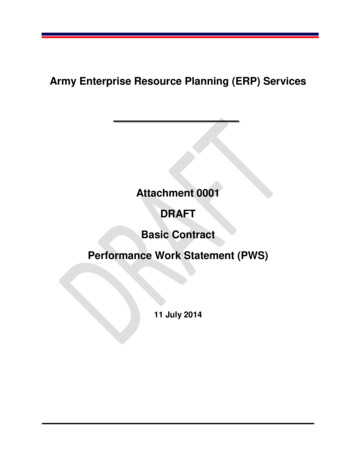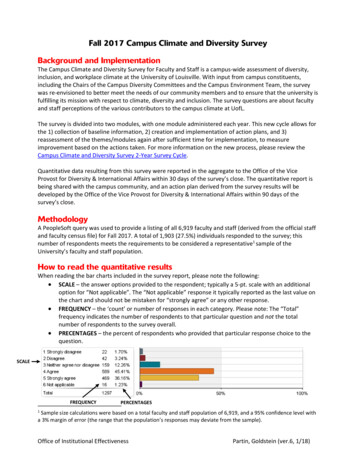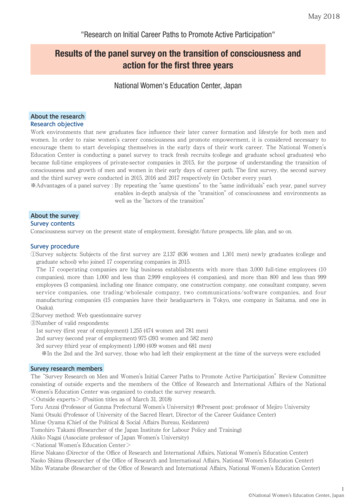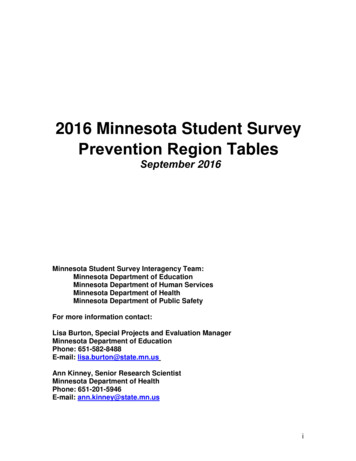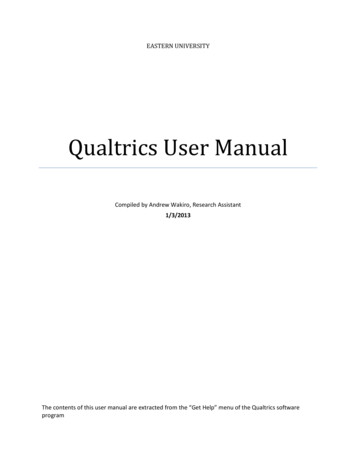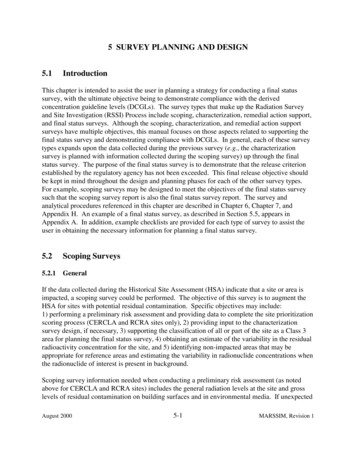
Transcription
5 SURVEY PLANNING AND DESIGN5.1IntroductionThis chapter is intended to assist the user in planning a strategy for conducting a final statussurvey, with the ultimate objective being to demonstrate compliance with the derivedconcentration guideline levels (DCGLs). The survey types that make up the Radiation Surveyand Site Investigation (RSSI) Process include scoping, characterization, remedial action support,and final status surveys. Although the scoping, characterization, and remedial action supportsurveys have multiple objectives, this manual focuses on those aspects related to supporting thefinal status survey and demonstrating compliance with DCGLs. In general, each of these surveytypes expands upon the data collected during the previous survey (e.g., the characterizationsurvey is planned with information collected during the scoping survey) up through the finalstatus survey. The purpose of the final status survey is to demonstrate that the release criterionestablished by the regulatory agency has not been exceeded. This final release objective shouldbe kept in mind throughout the design and planning phases for each of the other survey types.For example, scoping surveys may be designed to meet the objectives of the final status surveysuch that the scoping survey report is also the final status survey report. The survey andanalytical procedures referenced in this chapter are described in Chapter 6, Chapter 7, andAppendix H. An example of a final status survey, as described in Section 5.5, appears inAppendix A. In addition, example checklists are provided for each type of survey to assist theuser in obtaining the necessary information for planning a final status survey.5.2Scoping Surveys5.2.1GeneralIf the data collected during the Historical Site Assessment (HSA) indicate that a site or area isimpacted, a scoping survey could be performed. The objective of this survey is to augment theHSA for sites with potential residual contamination. Specific objectives may include:1) performing a preliminary risk assessment and providing data to complete the site prioritizationscoring process (CERCLA and RCRA sites only), 2) providing input to the characterizationsurvey design, if necessary, 3) supporting the classification of all or part of the site as a Class 3area for planning the final status survey, 4) obtaining an estimate of the variability in the residualradioactivity concentration for the site, and 5) identifying non-impacted areas that may beappropriate for reference areas and estimating the variability in radionuclide concentrations whenthe radionuclide of interest is present in background.Scoping survey information needed when conducting a preliminary risk assessment (as notedabove for CERCLA and RCRA sites) includes the general radiation levels at the site and grosslevels of residual contamination on building surfaces and in environmental media. If unexpectedAugust 20005-1MARSSIM, Revision 1
Survey Planning and Designconditions are identified that prevent the completion of the survey, the MARSSIM user shouldcontact the responsible regulatory agency for further guidance. Sites that meet the NationalContingency Plan criteria for a removal should be referred to the Superfund Removal program(EPA 1988c).If the HSA indicates that contamination is likely, a scoping survey could be performed to provideinitial estimates of the level of effort for remediation and information for planning a moredetailed survey, such as a characterization survey. Not all radiological parameters need to beassessed when planning for additional characterization because total surface activity or limitedsample collection may be sufficient to meet the objectives of the scoping survey.Once a review of pertinent site history indicates that an area is impacted, the minimum surveycoverage at the site will include a Class 3 area final status survey prior to the site being released.For scoping surveys with this objective, identifying radiological decision levels is necessary forselecting instruments and procedures with the necessary detection sensitivities to demonstratecompliance with the release criterion. A methodology for planning, conducting, anddocumenting scoping surveys is described in the following sections.5.2.2Survey DesignPlanning a scoping survey involves reviewing the HSA (Chapter 3). This process considersavailable information concerning locations of spills or other releases of radioactive material.Reviewing the radioactive materials license or similar documentation provides information onthe identity, locations, and general quantities of radioactive material used at the site. Thisinformation helps to determine which areas are likely to contain residual radioactivity and, thus,areas where scoping survey activities will be concentrated. The information may also identifyone or more non-impacted areas as potential reference areas when radionuclides of concern arepresent in background (Section 4.5). Following the review of the HSA, DCGLs that areappropriate for the site are selected. The DCGLs may be adjusted later if a determination ismade to use site-specific information to support the development of DCGLs.If residual radioactivity is identified during the scoping survey, the area may be classified asClass 1 or Class 2 for final status survey planning (refer to Section 4.4 for guidance on initialclassification), and a characterization survey is subsequently performed. For scoping surveys thatare designed to provide input for characterization surveys, measurements and sampling may notbe as comprehensive or performed to the same level of sensitivity necessary for final statussurveys. The design of the scoping survey should be based on specific data quality objectives(DQOs; see Section 2.3.1 and Appendix D) for the information to be collected.For scoping surveys that potentially serve to release the site from further consideration, thesurvey design should consist of sampling based on the HSA data and professional judgment. IfMARSSIM, Revision 15-2August 2000
Survey Planning and Designresidual radioactivity is not identified during judgment sampling, it may be appropriate toclassify the area as Class 3 and perform a final status survey for Class 3 areas. Refer to Section5.5 for a description of final status surveys. However, collecting additional information duringsubsequent surveys (e.g., characterization surveys) may be necessary to make a finaldetermination as to area classification.5.2.3Conducting SurveysScoping survey activities performed for preliminary risk assessment or to provide input foradditional characterization include a limited amount of surface scanning, surface activitymeasurements, and sample collection (smears, soil, water, vegetation, paint, building materials,subsurface materials). In this case, scans, direct measurements, and samples are used to examineareas likely to contain residual radioactivity. These activities are conducted based on HSA data,preliminary investigation surveys, and professional judgment.Background activity and radiation levels for the area should be determined, including directradiation levels on building surfaces and radionuclide concentrations in media. Survey locationsshould be referenced to grid coordinates, if appropriate, or fixed site features. It may beconsidered appropriate to establish a reference coordinate system in the event that contaminationis detected above the DCGLs (Section 4.8.5). Samples collected as part of a scoping surveyshould consider any sample tracking requirements, including chain of custody, if required(Section 7.8).Scoping surveys that are expected to be used as Class 3 area final status surveys should bedesigned following the guidance in Section 5.5. These surveys should also include judgmentmeasurements and sampling in areas likely to have accumulated residual radioactivity (Section5.5.3).5.2.4Evaluating Survey ResultsSurvey data are converted to the same units as those in which DCGLs are expressed (Section6.6). Identification of potential radionuclide contaminants at the site is performed using directmeasurements or laboratory analysis of samples. The data are compared to the appropriateregulatory DCGLs.For scoping survey activities that provide an initial assessment of the radiological hazards at thesite, or provide input for additional characterization, the survey data are used to identify locationsand general extent of residual radioactivity. Scoping surveys that are expected to be used asClass 3 area final status surveys should follow the methodology presented in Chapter 8 todetermine if the release criterion has been exceeded.August 20005-3MARSSIM, Revision 1
Survey Planning and Design5.2.5DocumentationHow the results of the scoping survey are documented depends on the specific objectives of thesurvey. For scoping surveys that provide additional information for characterization surveys, thedocumentation should provide general information on the radiological status of the site. Surveyresults should include identification of the potential contaminants (including the methods usedfor radionuclide identification), general extent of contamination (e.g., activity levels, area ofcontamination, and depth of contamination), and possibly even relative ratios of radionuclides tofacilitate DCGL application. A narrative report or a report in the form of a letter may suffice forscoping surveys used to provide input for characterization surveys. Sites being released fromfurther consideration should provide a level of documentation consistent with final status surveyreports.MARSSIM, Revision 15-4August 2000
Survey Planning and DesignEXAMPLE SCOPING SURVEY CHECKLISTSURVEY DESIGNEnumerate DQOs: State the objectives of the survey; survey instrumentation capabilitiesshould be appropriate for the specified survey objectives.Review the Historical Site Assessment for:Operational history (e.g., problems, spills, releases, or notices of violation) andavailable documentation (e.g., radioactive materials license).Other available resources—site personnel, former workers, residents, etc.Types and quantities of materials that were handled and where radioactivematerials were stored, handled, moved, relocated, and disposed.Release and migration pathways.Areas that are potentially affected and likely to contain residual contamination.Note: Survey activities will be concentrated in these areas.Types and quantities of materials likely to remain onsite—consider radioactivedecay.Select separate DCGLs for the site based on the HSA review. (It may be necessary toassume appropriate regulatory DCGLs in order to permit selection of survey methods andinstrumentation for the expected contaminants and quantities.)CONDUCTING SURVEYSFollow the survey design documented in the QAPP. Record deviations from the statedobjectives or documented SOPs and document additional observations made whenconducting the survey.Select instrumentation based on the specific DQOs of the survey. Consider detectioncapabilities for the expected contaminants and quantities.Determine background activity and radiation levels for the area; include direct radiationlevels on building surfaces, radionuclide concentrations in media, and exposure rates.August 20005-5MARSSIM, Revision 1
Survey Planning and DesignRecord measurement and sample locations referenced to grid coordinates or fixed sitefeatures.For scoping surveys that are conducted as Class 3 area final status surveys, followguidance for final status surveys.Conduct scoping survey, which involves judgment measurements and sampling based onHSA results:Perform investigatory surface scanning.Conduct limited surface activity measurements.Perform limited sample collection (smears, soil, water, vegetation, paint, buildingmaterials, subsurface materials).Maintain sample tracking.EVALUATING SURVEY RESULTSCompare survey results with the DQOs.Identify radionuclides of concern.Identify impacted areas and general extent of contamination.Estimate the variability in the residual radioactivity levels for the site.Adjust DCGLs based on survey findings (the DCGLs initially selected may not beappropriate for the site).Determine the need for additional action (e.g., none, remediate, more surveys)Prepare report for regulatory agency (determine if letter report is sufficient).MARSSIM, Revision 15-6August 2000
Survey Planning and Design5.3Characterization Surveys5.3.1GeneralCharacterization surveys may be performed to satisfy a number of specific objectives. Examplesof characterization survey objectives include: 1) determining the nature and extent of radiologicalcontamination, 2) evaluating remediation alternatives (e.g., unrestricted use, restricted use, onsitedisposal, off-site disposal, etc.), 3) input to pathway analysis/dose or risk assessment models fordetermining site-specific DCGLs (Bq/kg, Bq/m2), 4) estimating the occupational and publichealth and safety impacts during decommissioning, 5) evaluating remediation technologies,6) input to final status survey design, and 7) Remedial Investigation/Feasibility Studyrequirements (CERCLA sites only) or RCRA Facility Investigation/Corrective Measures Studyrequirements (RCRA sites only).The scope of this manual precludes detailed discussions of characterization survey design foreach of these objectives, and therefore, the user should consult other references for specificcharacterization survey objectives not covered. For example, the Decommissioning Handbook(DOE 1994) is a good reference for characterization objectives that are concerned withevaluating remediation technologies or unrestricted/restricted use alternatives. Other references(EPA 1988b, 1988c, 1994a; NRC 1994) should be consulted for planning decommissioningactions, including decontamination techniques, projected schedules, costs, and waste volumes,and health and safety considerations during decontamination. Also, the types of characterizationdata needed to support risk or dose modeling should be determined from the specific modelingcode documentation.This manual concentrates on providing information for the final status survey design, withlimited coverage on determining the specific nature and extent of radionuclide contamination.The specific objectives for providing information to the final status survey design include:1) estimating the projected radiological status at the time of the final status survey, in terms ofradionuclides present, concentration ranges and variances, spatial distribution, etc., 2) evaluatingpotential reference areas to be used for background measurements, if necessary, 3) reevaluatingthe initial classification of survey units, 4) selecting instrumentation based on the necessaryMDCs, and 5) establishing acceptable Type I and Type II errors with the regulatory agency(Appendix D provides guidance on establishing acceptable decision error rates). Many of theseobjectives are satisfied by determining the specific nature and extent of contamination ofstructures, residues, and environmental media. Additional detail on the performance ofcharacterization surveys designed to determine the general extent of contamination can be foundin the NRC's Draft Branch Technical Position on Site Characterization for Decommissioning(NRC 1994a) and EPA's RI/FS guidance (EPA 1988b; EPA 1993c).August 20005-7MARSSIM, Revision 1
Survey Planning and DesignResults of the characterization survey should include: 1) the identification and distribution ofcontamination in buildings, structures, and other site facilities; 2) the concentration anddistribution of contaminants in surface and subsurface soils; 3) the distribution and concentrationof contaminants in surface water, ground water, and sediments, and 4) the distribution andconcentration of contaminants in other impacted media such as vegetation or paint. Thecharacterization should include sufficient information on the physical characteristics of the site,including surface features, meteorology and climatology, surface water hydrology, geology,demography and land use, and hydrogeology. This survey should also address environmentalconditions that could affect the rate and direction of contaminant transport in the environment,depending on the extent of contamination identified above.The following sections describe a method for planning, conducting, and documentingcharacterization surveys. Alternative methodologies may also be acceptable to the regulatoryagencies.5.3.2Survey DesignThe design of the site characterization survey is based on the specific DQOs for the informationto be collected, and is planned using the HSA and scoping survey results. The DQO Processensures that an adequate amount of data with sufficient quality are collected for the purpose ofcharacterization. The site characterization process typically begins with a review of the HSA,which includes available information on site description, operational history, and the type andextent of contamination (from the scoping survey, if performed). The site description, orconceptual site model as first developed in Section 3.6.4, consists of the general area,dimensions, and locations of contaminated areas on the site. A site map should show siteboundaries, roads, hydrogeologic features, major structures, and other features that could affectdecommissioning activities.The operational history includes records of site conditions prior to operational activities,operational activities of the facility, effluents and on-site disposal, and significantincidents—including spills or other unusual occurrences—involving the spread of contaminationaround the site and on areas previously released from radiological controls. This review shouldinclude other available resources, such as site personnel, former workers, residents, etc. Historicaerial photographs and site location maps may be particularly useful in identifying potential areasof contamination.The types and quantities of materials that were handled and the locations and disposition ofradioactive materials should be reviewed using available documentation (e.g., the radioactivematerials license). Contamination release and migration pathways should be identified, as wellas areas that are potentially affected and are likely to contain residual contamination. The typesand quantities of materials likely to remain onsite, considering radioactive decay, should bedetermined.MARSSIM, Revision 15-8August 2000
Survey Planning and DesignThe characterization survey should clearly identify those portions of the site (e.g., soil, structures,and water) that have been affected by site activities and are potentially contaminated. The surveyshould also identify the portions of the site that have not been affected by these activities. Insome cases where no remediation is anticipated, results of the characterization survey mayindicate compliance with DCGLs established by the regulatory agency. When planning for thepotential use of characterization survey data as part of the final status survey, the characterizationdata must be of sufficient quality and quantity for that use (see Section 5.5). There are severalprocesses that are likely to occur in conjunction with characterization. These include consideringand evaluating remediation alternatives, and calculating site-specific DCGLs.The survey should also provide information on variations in the contaminant distribution in thesurvey area. The contaminant variation in each survey unit contributes to determining thenumber of data points based on the statistical tests used during the final status survey (Section5.5.2). Additionally, characterization data may be used to justify reclassification for some surveyunits (e.g., from Class 1 to Class 2).Note that because of site-specific characteristics of contamination, performing all types ofmeasurements described here may not be relevant at every site. For example, detailedcharacterization data may not be needed for areas with contamination well above the DCGLs thatclearly require remediation. Judgment should be used in determining the types ofcharacterization information needed to provide an appropriate basis for decontaminationdecisions.5.3.3Conducting SurveysCharacterization survey activities often involve the detailed assessment of various types ofbuilding and environmental media, including building surfaces, surface and subsurface soil,surface water, and ground water. The HSA data should be used to identify the potentiallycontaminated media onsite (see Section 3.6.3). Identifying the media that may containcontamination is useful for preliminary survey unit classification and for planning subsequentsurvey activities. Selection of survey instrumentation and analytical techniques are typicallybased on a knowledge of the appropriate DCGLs, because remediation decisions are made basedon the level of the residual contamination as compared to the DCGL. Exposure ratemeasurements may be needed to assess occupational and public health and safety. The locationof underground utilities should be considered before conducting a survey to avoid compoundingthe problems at the site.August 20005-9MARSSIM, Revision 1
Survey Planning and Design5.3.3.1 Structure SurveysSurveys of building surfaces and structures include surface scanning, surface activitymeasurements, exposure rate measurements, and sample collection (e.g., smears, subfloor soil,water, paint, and building materials). Both field survey instrumentation (Chapter 6) andanalytical laboratory equipment and procedures (Chapter 7) are selected based on their detectioncapabilities for the expected contaminants and their quantities. Field and laboratory instrumentsare described in Appendix H.Background activity and radiation levels for the area should be determined from appropriatebackground reference areas. Background assessments include surface activity measurements onbuilding surfaces, exposure rates, and radionuclide concentrations in various media (refer toSection 4.5).Measurement locations should be documented using reference system coordinates, if appropriate,or fixed site features. A typical reference system spacing for building surfaces is 1 meter. This ischosen to facilitate identifying survey locations, evaluating small areas of elevated activity, anddetermining survey unit average activity levels.Scans should be conducted in areas likely to contain residual activity, based on the results of theHSA and scoping survey.Both systematic and judgment surface activity measurements are performed. Judgment directmeasurements are performed at locations of elevated direct radiation, as identified by surfacescans, to provide data on upper ranges of residual contamination levels. Judgment measurementsmay also be performed in sewers, air ducts, storage tanks, septic systems and on roofs ofbuildings, if necessary. Each surface activity measurement location should be carefully recordedon the appropriate survey form.Exposure rate measurements and media sampling are performed as necessary. For example,subfloor soil samples may provide information on the horizontal and vertical extent ofcontamination. Similarly, concrete core samples are necessary to evaluate the depth of activatedconcrete in a reactor facility. Note that one type of radiological measurement may be sufficientto determine the extent of contamination. For example, surface activity measurements alone maybe all that is needed to demonstrate that decontamination of a particular area is necessary;exposure rate measurements would add little to this determination.Lastly, the measuring and sampling techniques should be commensurate with the intended use ofthe data, as characterization survey data may be used to supplement final status survey data,provided that the data meet the selected DQOs.MARSSIM, Revision 15-10August 2000
Survey Planning and Design5.3.3.2 Land Area SurveysCharacterization surveys for surface and subsurface soils and media involve employingtechniques to determine the lateral and vertical extent and radionuclide concentrations in the soil.This may be performed using either sampling and laboratory analyses, or in situ gammaspectrometry analyses, depending on the detection capabilities of each methodology for theexpected contaminants and concentrations. Note that in situ gamma spectrometry analyses orany direct surface measurement cannot easily be used to determine vertical distributions ofradionuclides. Sample collection followed by laboratory analysis introduces several additionalsources of uncertainty that need to be considered during survey design. In many cases, acombination of direct measurements and samples is required to meet the objectives of the survey.Radionuclide concentrations in background soil samples should be determined for a sufficientnumber of soil samples that are representative of the soil in terms of soil type, soil depth, etc. Itis important that the background samples be collected in non-impacted areas. Considerationshould be given to spatial variations in the background radionuclide concentrations as discussedin Section 4.5 and NRC draft report NUREG-1501 (NRC 1994b).Sample locations should be documented using reference system coordinates (see Section 4.8.5),if appropriate, or fixed site features. A typical reference system spacing for open land areas is 10meters (NRC 1992a). This spacing is somewhat arbitrary and is chosen to facilitate determiningsurvey unit locations and evaluating areas of elevated radioactivity.Surface scans for gamma activity should be conducted in areas likely to contain residual activity.Beta scans may be appropriate if the contamination is near the surface and represents theprominent radiation emitted from the contamination. The sensitivity of the scanning techniqueshould be appropriate to meet the DQOs.Both surface and subsurface soil and media samples may be necessary. Subsurface soil samplesshould be collected where surface contamination is present and where subsurface contaminationis known or suspected. Boreholes should be constructed to provide samples representingsubsurface deposits.Exposure rate measurements at 1 meter above the sampling location may also be appropriate.Each surface and subsurface soil sampling and measurement location should be carefullyrecorded.August 20005-11MARSSIM, Revision 1
Survey Planning and Design5.3.3.3 Other Measurements/Sampling LocationsSurface Water and Sediments. Surface water and sediment sampling may be necessarydepending on the potential for these media to be contaminated. The contamination potentialdepends on several factors, including the proximity of surface water bodies to the site, size of thedrainage area, total annual rainfall, and spatial and temporal variability in surface water flow rateand volume. Refer to Section 3.6.3.3 for further consideration of the necessity for surface waterand sediment sampling.Characterizing surface water involves techniques that determine the extent and distribution ofcontaminants. This may be performed by collecting grab samples of the surface water in a wellmixed zone. At certain sites, it may be necessary to collect stratified water samples to provideinformation on the vertical distribution of contamination. Sediment sampling should also beperformed to assess the relationship between the composition of the suspended sediment and thebedload sediment fractions (i.e., suspended sediments compared to deposited sediments). Whenjudgment sampling is used to find radionuclides in sediments, contaminated sediments are morelikely to be accumulated on fine-grained deposits found in low-energy environments (e.g.,deposited silt on inner curves of streams).Radionuclide concentrations in background water samples should be determined for a sufficientnumber of water samples that are upstream of the site or in areas unaffected by site operations.Consideration should be given to any spatial or temporal variations in the backgroundradionuclide concentrations.Sampling locations should be documented using reference system coordinates, if appropriate, orscale drawings of the surface water bodies. Effects of variability of surface water flow rateshould be considered. Surface scans for gamma activity may be conducted in areas likely tocontain residual activity (e.g., along the banks) based on the results of the document reviewand/or preliminary investigation surveys.Surface water sampling should be performed in areas of runoff from active operations, at plantoutfall locations, both upstream and downstream of the outfall, and any other areas likely tocontain residual activity (see Section 3.6.3.3). Measurements of radionuclide concentrations inwater should include gross alpha and gross beta assessments, as well as any necessaryradionuclide-specific analyses. Non-radiological parameters, such as specific conductance, pH,and total organic carbon may be used as surrogate indicators of potential contamination, providedthat a specific relationship exists between the radionuclide concentration and the level of theindicator (e.g., a linear relationship between pH and the radionuclide concentration in water isfound to exist, then the pH may be measured such that the radionuclide concentration can becalculated based on the known relationship rather than performing an expensive nuclide-specificanalysis). The use of surrogate measurements is discussed in Section 4.3.2.MARSSIM, Revision 15-12June 2001
Survey Planning and DesignEach surface water and sediment sampling location should be carefully recorded on theappropriate survey form. Additionally, surface water flow models may be used to illustratecontaminant concentrations and migration rates.Ground Water. Ground-water sampling may be necessary depending on the local geology,potential for subsurface contamination, and the regulatory framework. Because differentagencies handle ground water contamination situations in different ways (e.g., EPA’s Superfundprogram and some States
The design of the scoping survey should be based on specific data quality objectives (DQOs; see Section 2.3.1 and Appendix D) for the information to be collected. For scoping surveys that potentially serve to release the site from further consideration, the survey design should consist of sampling based on the HSA data and professional judgment. If




